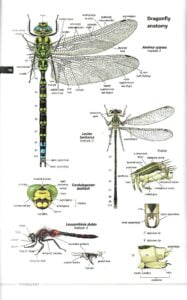The Odonata, dragonflies and damselflies, is one of our most fascinating groups of insects. As adults, they’re comparatively large and highly active, which makes them one of the most noticeable and easiest insect groups to watch.

From spring, through summer into autumn, dragonflies and damselflies are on my radar whenever I’m out for a tramp around my local patch or guiding a group a little further afield. It’s always a delight to watch their bejewelled antics and, particularly with dragonflies, their aeronautic prowess.
Seeing them is one thing… identifying them can be quite another. Beyond a few common species you quickly familiarise yourself with, they can be quite a challenge, and the fact they move so quickly can make getting good views of key ID features tricky. A good field guide is indispensable if you want to identify the dragonflies and damselflies you see.
The “Field Guide to the Dragonflies of Britain and Europe” by Klaas-Douwe B. Dijkstra, illustrated by Richard Lewington, Published by Bloomsbury Wildlife Guides, is one such guide.
Described by the authors as a “next generation field guide”, the book certainly has a contemporary feel about it. There’s a comprehensive introduction covering how to watch and study dragonflies, dragonfly behaviour, life-cycle and habitats, anatomy and a detailed section on how to go about trying to identify the species you see.
One thing that’s different about this guide is its scope. Covering the whole of Europe, it’s a lot meatier than most other field guides you’ll encounter (which typically only cover the dragonflies found in Britain and Ireland). That means, when we’re allowed out again post COVID, it will come in handy on those trips to the continent, and should cover you if you encounter the occasional European vagrant on your local patch. The flip side is that there are more species to look through to narrow down your search for an ID — although the excellent distribution maps should help on that score.

After the introduction, and before the main species accounts, you’ll find a Regional Guide to Dragonflies discussing the different countries/regions covered, including a short section on Ireland, written by Irish insect specialist Brian Nelson, outlining the climate, habitat and general distribution of dragonfly/damselfly populations across the island.
Then comes the “business end” of the book, if you like: the individual species accounts. Organised taxonomically, they start with the damselflies and move on to dragonflies. The accounts are detailed, with most species given at least a full page, and many getting a double-page-spread (text and figures on one page, including a detailed distribution map, with illustrations on the facing page).

The information provided for each species is comprehensive, and thoughtfully laid out, making it easy to find relevant information quickly. The illustrations are sublime: some of the best insect artwork I’ve ever seen. Each species depicted in exquisite detail, in male and female forms where appropriate, and with close-up illustrations of key identification features where necessary. The illustrations capture those critical features in a way photographs rarely can, but for many species the authors have included photographs too, so you get the best of both worlds.

An extremely handy feature on this guide — one I wish more field-guide publishers would adopt — is the addition of colour bands to denote different sections. When the book is closed, colour-coded backgrounds behind the page numbers show as visible colour-bands on the outer edge of the pages. It means you can open the book at the section you want without hunting around. It’s simple… and very effective (Bloomsbury use the same system in their iconic “Field Guide to the Moths of Great Britain and Ireland”).
Overall, this book is a superb field guide to all dragonflies and damselflies you’re likely to encounter in Europe. It’s scope might be a little broad if you’re just getting started, when your focus is only on Irish species. Having to leaf through species that don’t occur here to narrow down what you’re looking at can be a bit confusing. Ultimately though, this is a book that will continue to serve you well should your interest in dragonflies and damselflies blossom, and take you further afield.
You can view details of this publication on Bloomsbury’s website here, or pick up your copy on Amazon.
NB. This review is based on the first edition of the book. Bloomsbury has just released (October 2020) the second edition.










1 comment
Dr.Jisha Krishnan E.K
Hello dear sir
I am Dr Jisha Krishnan E.K currently working as an assistant professor in Zoology in one of the colleges in Kerala state of India. I would like to publish a book on molecular barcoding of Odonates in Kerala, as it was my Ph.,D work.I do have the data only on Molecular aspects of Odonates.Would you please suggest some guidelines for publishing a book in this area because this is the first time Iam about to write a book.